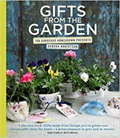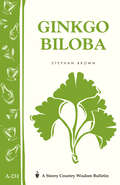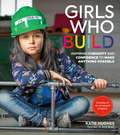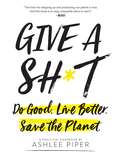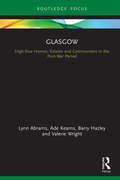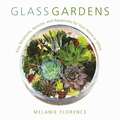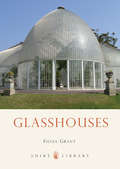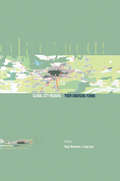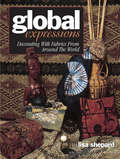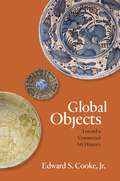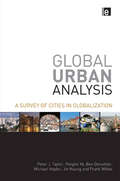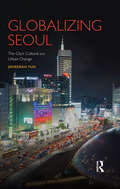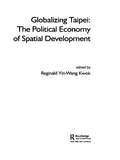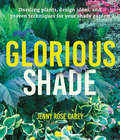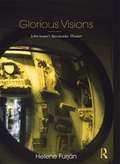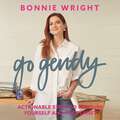- Table View
- List View
Gifts from the Garden
by Debora RobertsonBrimming with ideas from the pretty to the practical, Gifts from the Garden contains more than 100 projects that use the gardener's bounty throughout the seasons. Divided into Flowers and Herbs, and Fruit and Vegetables, Debora includes gifts that are edible, for your home and for your wellbeing. There are potted bulbs in teacups and decorated personal seed packets, a lavender, rose and chamomile bubble bath, flower and fruit lip balms, a tisane planter and a pizza herb window box, as well as festive wreaths and ideas for using flowers and foliage when wrapping presents. And of course delicious ideas like toffee apples, herbal teas, spice rubs, chilli jams, courgette muffins and quince vodka to name a few! So whether you want to give something practical for the home, indulgent to enjoy at bath time, or to complement a delicious dinner, there is a present that will suit everyone.
Gifts in Jars: Homemade Cookie Mixes, Soup Mixes, Candles, Lotions, Teas, and More!
by Natalie WiseLearn to make dozens of unique gifts packaged perfectly in glass jars of various shapes and sizes. Do you have an aspiring gardener on your list? Make a "plant bomb" jar with your favorite flower seeds or an adorable terrarium featuring easy-to-grow air plants. Headed to a bridal shower? Pamper your friend with a manicure kit or mint mojito lip scrub. Who wouldn't love some homemade sugar cookie mix or healthy and delicious granola in an attractive and reusable jar?Glass jars are easy to come by, cute, and incredibly versatile. Fill them with customized treasures to delight anyone on your list. Projects include:Light-Up Fairy JarBarbecue RubHot Fudge ToppingSnowglobe ScenesVanilla Citrus Sugar Hand ScrubCitronella Oil LampBird FeederAnd more!Complete with tips for decorating jars, suggestions for gift tags, and inspiring full-color photographs, Gifts in Jars is here to make your holiday gift list a whole lot more fun.
Gil Walsh Interiors: A Case for Color
by Gil Walsh Margaret Reilly MuldoonThe award-winning interior designer and owner of Gil Walsh Interiors shares her colorful approach to style in this beautifully illustrated volume. Master colorist Gil Walsh has spent decades bringing her expertise to elegant homes from Pennsylvania to West Palm Beach, Martha&’s Vineyard, and beyond. Now she brings readers into her creative process, showing how she helps clients express their personal lifestyles through inviting and gorgeously vibrant interiors. With stunning photography, this volume demonstrates how color can be enjoyed with gusto, whether in pretty pastels or bold, bright hues. From beach houses in the Florida Keys to sky-scraping apartments in Palm Beach, historic landmark buildings such as Fallingwater and the Duquesne Club in Pennsylvania, and a cozy cottage on Martha&’s Vineyard, Gil has applied her artistic eye and techniques to a wide variety of interiors and period styles.
Ginkgo Biloba: Storey Country Wisdom Bulletin, A-231 (Storey Country Wisdom Bulletin Ser.)
by Stephan BrownGinkgo biloba has been proven to improve short-term memory, alleviate allergies, relieve depression, and boost circulation. In Ginkgo Biloba, ginkgo farmer Stephan Brown shows you how to successfully grow ginkgo as a cash crop or for your own use. He also shares his recipes for making a range of healing remedies, from teas, tinctures, and tonics to a hearty and delicious Ginkgo Chicken Stew, which helps the immune system fight off colds and flus.
Ginseng
by Kim Derek PrittsDetailed guide to growing your own ginseng plus how to sell and use the plant after harvesting. Finding, harvesting, and conserving ginseng in the wild. Updates include information about state regulations and scientific studies of ginseng's nearest neighbors.
Girls Who Build: Inspiring Curiosity and Confidence to Make Anything Possible
by Katie HughesCelebrate the can-do attitude of fierce girls who know how to wield a hammer, fire up a saw, and build everything from a bookshelf to a playhouse. Featuring project photographs, this guide will inspire you to pick up your power tools and make something great.Carpenter Katie Hughes frequently found that she was the only woman on construction worksites. To change that, she began teaching classes to girls ages 8-14, showing them how to drill, saw, and weld. Her classes quickly became sold out summer camps and she founded her own non-profit, Girls Build.Girls Who Build features candid and arresting photographs of forty-five girls showing off their power tools and can-do attitudes. Accompanying each girl is a profile interview where she speaks to her inspirations and favorite builds, plus tips for others starting out. Also included are building skills, techniques, and safety tips to teach girls -- and older beginners -- how to handle hammers, drills, and saws plus thirteen do-it-herself building projects (from the featured girls themselves) such as picture frames, nightstands, playhouses, and more.
Give a Sh*t: Do Good. Live Better. Save the Planet.
by Ashlee Piper"The time for stepping up and protecting our planet is now. And this book is an easy, enjoyable place to start." -- MobyIt's time to put your good intentions into action. It's time to give a shit -- about your health, your footprint, and your planet.Give a Sh*t guides you through the transition to a kinder, healthier, more conscious, and sustainable life like no book has done before. With a humorous and nonjudgmental tone, savvy eco-friendly lifestyle expert Ashlee Piper walks you through easy-but-impactful shifts anyone can make to live and be better every damn day:In your home - Room-by-room guidance and tactics for a chic, affordable, sustainable living space, no matter where or how you liveIn the kitchen - 20+ unfussy, quick, and delicious plant-based recipes for every life occasion, from pantry staples like White Witch Almond Milk to exciting everyday fare like Walnut Chorizo Tostadas to kick-ass desserts like Jamocha Silk PieIn your closet - Advice for building a polished, ethical wardrobe in a world of fast fashionIn the mirror - Beauty and grooming tips and DIY products (from skin care to foundation to, ahem, ladytime provisions) that are safer, natural, cruelty-free, and, best of all, effectiveIn the wild - How to maintain your values (and your moxie) at work, in your social life, and when abroadGive a Sh*t isn't a manual of restrictions -- it's a practical handbook that meets you where you are and finally harmonizes doing good with living well.
Give it a Grow: The Instant Bestseller. Simple Projects to Nurture Food, Flowers and Wildlife in any Outdoor Space
by Martha SwalesThe ultimate beginner’s guide to growing veg, fruit, flowers and nurturing wildlife in your garden, patio or window sill, order your copy now! ‘A true joy to read’ - Yotam OttolenghiIn this beautiful and practical guide, Martha Swales makes it easier than ever before to start growing your own slice of nature with her collection of fool-proof projects.You don’t need expensive tools or equipment, Martha’s approach is all about getting outside, trying something new and watching the magic of nature take its course. With chapters on veg, fruit, herbs, flowers and wildlife, there are over 40 of Martha’s favourite projects to make the most of your garden, patio or balcony (plus bonus recipes for how to cook with your produce!) including:Grow garlic greens on your windowsill (and use them to make tasty garlic flatbreads)Create a tower of tumbling strawberriesBuild a pond to bring wildlife to your gardenMake a bulb lasagne for a changing display of flowers throughout springComplete with beautiful illustrations, this is the perfect book for anyone who wants to get more out of their outside space, to enjoy the taste of their own produce, or to simply feel more connected to nature – why don’t you give it a grow?‘Everything this book is celebrating just makes life better - for you and the world around you’ - Hugh Fearnley-Whittingstall
Glasgow: High-Rise Homes, Estates and Communities in the Post-War Period (Built Environment City Studies)
by Lynn Abrams Barry Hazley Ade Kearns Valerie WrightIn the wake of an unparalleled housing crisis at the end of the Second World War, Glasgow Corporation rehoused the tens of thousands of private tenants who were living in overcrowded and unsanitary conditions in unimproved Victorian slums. Adopting the designs, the materials and the technologies of modernity they built into the sky, developing high-rise estates on vacant sites within the city and on its periphery. This book uniquely focuses on the people's experience of this modern approach to housing, drawing on oral histories and archival materials to reflect on the long-term narrative and significance of high-rise homes in the cityscape. It positions them as places of identity formation, intimacy and well-being. With discussions on interior design and consumption, gender roles, children, the elderly, privacy, isolation, social networks and nuisance, Glasgow examines the connections between architectural design, planning decisions and housing experience to offer some timely and prescient observations on the success and failure of this very modern housing solution at a moment when high flats are simultaneously denigrated in the social housing sector while being built afresh in the private sector. Glasgow is aimed at an academic readership, including postgraduate students, scholars and researchers. It will be of interest to social, cultural and urban historians particularly interested in the United Kingdom.
Glass Gardens: Easy Terrariums, Aeriums, and Aquariums for Your Home or Office
by Melanie FlorenceNot everyone can be Martha Stewart, and luckily you don’t need to be to create beautiful terrariums to display in your space or to give as a gift. With simple instructions and a relaxed and pleasant tone, Glass Gardens speaks to the beginner terrarium-maker as a best friend would over a cup of coffee or tea. You won’t find any overly elaborate or complicated projects here! With just a few supplies and a small amount of time, you’ll have a gorgeous centerpiece to display or give away.Learn how to create stunning, easy-to-maintain terrariums with cacti and succulents, as well as water terrariums (aquariums) with plants you can buy at your local pet store and air terrariums (aeriums), which are by far the easiest type of terrarium to create and keep alive.In Glass Gardens, you’ll be given lists of supplies you’ll need as well as information on where to find them in addition to tips and tricks about the best ways to keep your plants alive and thriving. Easy, step-by-step instructions and detailed photos will have you designing your own glass gardens before you know it.
Glasshouses
by Fiona GrantThe orangeries and glasshouses that stand in the gardens of many stately homes help to tell a three-century story of garden fashion. They reflect both the architectural and social trends of their time, but above all show an increasing ability to tailor the buildings to the needs of the plants within. Starting with the Restoration fashion for cultivating pineapples, oranges and bananas within palatial orangeries, Fiona Grant then explains the development of glasshouses through the eighteenth century into the heyday of diversification and specialisation that charaterized the Victorian period, to the eventual decline of great glasshouses after the First World War. The role of the glasshouse as a display of status and of an interest in botany, technology and architecture is explored, and the book is colorfully illustrated throughout.
Global City Regions: Their Emerging Forms
by Roger Simmonds Gary HackA unique comparative study based on funded research, of eleven city regions across three continents looking at changes over the last 30 years. Detailed changes in land use are presented here with series of maps prepared especially for the study. The socio-economic and physical forms of city regions have been examined for comparative study and the findings will be of interest to all those concerned with urban development in their professional and academic work. The book features numerous maps which underline research findings. Cities covered are: Ankara, Bangkok, Boston, Madrid, Randstad, San Diego, Chile, Sao Paulo, Seattle and the Central Puget, Taipei, Tokyo, West Midlands.
Global City Typologies: Transactional Forces in Urbanised Development
by Nigel C. LewisGlobal City Typologies explores the historical, cultural and socio-economic transactional forces in the development of existing cities through to newly planned and emerging cities. Individual chapters address different sets and typologies of global cities to analyse their comparative evolution and standing today. The separate parts and individual chapters have been grouped around 125 different established, planned and emerging cities and analysed according to different typologies and thematic categories that comprise historic cities, early trading cities, planned cities, emerging global cities, mega cities and megalopolitan agglomerations. These span five continents – including the industrial cities of Chicago and Manchester, new capitals such as Brasília and New Delhi, innovative cities such as Singapore and Tel Aviv and mega cities such as Mexico City. The book is fully illustrated throughout with modern and historical maps, which enables visualisation of the forces that have shaped ongoing development of these major global cities. This is an essential book for students and professionals in urban design and planning, administrators, economists, designers and developers.
Global Expressions: Decorating With Fabrics from Around the World
by Lisa ShepardThe fabrics we use to create clothing and home decor reflect our culture and heritage. This book takes readers around the world as it introduces them to fabric techniques through interviews with experts in the field. From sadza batik in Zimbabwe to Japanese sashiko quilting, the authentic method for creating each fabric is explained, along with simplified instructions for recreating the look. Color photographs, patterns, designs and stencils assist readers in utilizing the fabric for unique home decor. Includes an extensive appendix, a detailed glossary and traceable patterns. This book features 12 fabric styles and 15 projects. It offers information on the authentic fabric, how it is created and its place in the culture of the country. Global Expressions presents easy-to-follow directions on how to recreate the fabric.
Global Green Infrastructure: Lessons for successful policy-making, investment and management
by Ian MellOver the last decade research exploring green infrastructure planning has burgeoned. Transferable green infrastructure messages between locations though are less well established and there remains a visible gap between the conceptual understanding of green infrastructure and its application in practice. Drawing together evaluations of green infrastructure policy-making and practice from across the world Global Green Infrastructure illustrates where successful practices can be identified. Examples from major green infrastructure development areas in the UK, Europe and the USA highlight the variety of investment options that can deliver socio-economic benefits. There is also a growing awareness of the added value of landscape planning in the rapidly developing cities of India and China. Reflecting on ten international case studies Global Green Infrastructure highlights the ways that ecology and engineered solutions can deliver successful urban development. Based on in situ research with the growing community of green infrastructure researchers and practitioners Global Green Infrastructure looks at the contradictions, consensus, and expanding evidence base of successful investments. This book also presents an in-depth commentary on the contemporary approaches to investment in urban greening and green infrastructure, and draws on the lessons we have learnt from a decade of experimentation, delivery and reflection.
Global Iconoclasm: Contesting “Official” Mnemonic Landscapes (RaumFragen: Stadt – Region – Landschaft)
by Michael Ripmeester Matthew W. RofeGeographers – and others – have been long aware that landscapes are neither natural or neutral. This is particularly true of landscapes of memory. Powerful groups inscribe such landscapes with both a preferred vision of the past and with sets of idealized societal values, and morays. Yet, and despite the authoritative weight such landscapes carry, they can be challenged. Even before the monument topplings of 2020, groups across the globe were challenging official memory discourses. This volume offers case studies of what might be considered global iconoclasm. Drawing upon original international case studies, this monograph critically engages with and reveals the dynamics of landscape contestation. From the Tsunami Museum of Banda Aceh to the echoes of Mussolini’s Fascist Italy by way of the decolonization of sites in Australia, New Zealand, Colombia and Africa the processes of landscape contestation are innovatively teased out by established and newly emerging scholars. This book should be of interest to any scholar interested in the politics of mnemonic landscapes.
Global Objects: Toward a Connected Art History
by Edward S. CookeA bold reorientation of art history that bridges the divide between fine art and material culture through an examination of objects and their usesArt history is often viewed through cultural or national lenses that define some works as fine art while relegating others to the category of craft. Global Objects points the way to an interconnected history of art, examining a broad array of functional aesthetic objects that transcend geographic and temporal boundaries and challenging preconceived ideas about what is and is not art.Avoiding traditional binaries such as East versus West and fine art versus decorative art, Edward Cooke looks at the production, consumption, and circulation of objects made from clay, fiber, wood, and nonferrous base metals. Carefully considering the materials and process of making, and connecting process to product and people, he demonstrates how objects act on those who look at, use, and acquire them. He reveals how objects retain aspects of their local fabrication while absorbing additional meanings in subtle and unexpected ways as they move through space and time. In emphasizing multiple centers of art production amid constantly changing contexts, Cooke moves beyond regional histories driven by geography, nation-state, time period, or medium.Beautifully illustrated, Global Objects traces the social lives of objects from creation to purchase, and from use to experienced meaning, charting exciting new directions in art history.
Global Urban Analysis: A Survey of Cities in Globalization
by Ben Derudder Frank Witlox Pengfei Ni Michael Hoyler Jin Huang Peter J TaylorGlobal Urban Analysis provides a unique insight into the contemporary world economy through a focus on cities. It is based upon a large-scale customised data collection on how leading businesses use cities across the world: as headquarter locations, for finance, for professional and creative services, for media. These data - involving up to 2000 firms and over 500 cities - provide evidence for both how the leading cities, sometimes called global cities, are coming to dominate the world economy, and how hundreds of other cities are faring in this brave new urban world. Thus can the likes of London, New York and Hong Kong be tracked as well as Manchester, Cleveland and Guangzhou, and even Plymouth, Chattanooga and Xi'an. Cities are assessed and ranked in terms of their importance for various functions such as for financial services, legal services and advertising, plus novel findings are reported for the geographical orientations of their connections. This is truly a comprehensive survey of cities in globalization covering global, world-regional, and national scales of analysis: - 4 key chapters outline the global structure of the world economy featuring the leading cities; - 9 regional chapters covering the whole world also feature the level of services provided by 'medium' cities; - 22 chapters on selected countries and sub-regions indicate global-ness and local-ness and feature an even wider range of cities. Written in an easy to understand style, this book is a must read for anybody interested in their own city in the world and how it relates to other cities.
Globalizing Seoul: The City's Cultural and Urban Change (Planning, History and Environment Series)
by Jieheerah YunIn the decades following the 1997 Asian economic crisis, South Korea sought segyehwa (globalization). Evidence of this is no more evident than in the country’s capital, Seoul, where urban development has been central to making the city a global hub and not just the centre of the national economy. However, recent development projects differ from those of the past in that they no longer focus solely on economic efficiency, but on the deployment of a new urban aesthetics. As Jieheerah Yun reveals in Globalizing Seoul: The City’s Cultural and Urban Change, the pursuit of globalization and the rebranding of Seoul’s image from hard industrial city to soft cultural city have shaped the urban development of the city. Following a brief urban history of Seoul, she focuses on two key themes. In the first, how globalization has contributed to refashioning Korean traditions, she analyzes the policies and actions to preserve Korean folk houses and pre-industrial street layouts, looking in detail at the Bukchon and Insadong areas of the city. Her second theme is an examination of migration and the generation of new minority neighbourhoods amidst the segyehwa policies and the state’s efforts to build a multicultural society. In detailed case studies of the redevelopment of Dongdaemun Market as part of rebranding Seoul as the ‘world design capital’ and of the Itaewon area as both a Special Tourist Zone and a Global Cultural Zone, she shows how multi-ethnic neighbourhoods are threatened by lack of consideration for economic justice and housing provision.
Globalizing Taipei: The Political Economy of Spatial Development (Planning, History and Environment Series)
by Reginald Yin-Wang KwokTaipei's quest to become a global city is the key to its urban development. Globalizing Taipei looks at this "Asian Dragon", a major city in the South China Growth Triangle and a centre for transnational production, revealing how the development of this capital has received firm state support but is conditioned by international and domestic politics.The book is divided into four parts: economic and spatial restructuring, state and society realignment, social differentiation and cultural reorientation. Each analyzes the interaction of international, state and local politics in the shaping of the city's urban environment since World War II.All contributors to this edited volume are Taiwan scholars presenting critical insiders' views. Based on each author's specialization and research focus, each chapter provides an in-depth consideration of one of Taipei's developmental issues generated by globalization. Collectively they provide broad, insightful and coherent coverage of this crucial time in Taipei's global transmutation.
Glorious Shade: Dazzling Plants, Design Ideas, and Proven Techniques for Your Shady Garden
by Jenny Rose CareyTurn a shady yard into a sumptuous gardenShade is one of the most common garden situations homeowner’s have, but with the right plant knowledge, you can triumph over challenging areas and learn to embrace shade as an opportunity instead of an obstacle. Glorious Shade celebrates the benefits of shade and shows you how to make the most of it. This information-rich, hardworking guide is packed with everything you need to successfully garden in the shadiest corners of a yard. You'll learn how to determine what type of shade you have and how to choose the right plants for the space. The book also shares the techniques, design and maintenance tips that are key to growing a successful shade garden. Stunning color photographs offer design inspiration and reveal the beauty of shade-loving plants.
Glorious Visions: John Soane's Spectacular Theater
by Helene FurjánFocusing on the house and museum and its considerable collections of architectural fragments, models, drawings folios and publications, this book is about thirteen Lincoln’s Inn Fields in London, England, built in the early 1800s by the renowned eighteenth-century architect Sir John Soane. The book maps the influences, references, connections, extensions, and productions at play in Soane’s house-museum. The house, still a public museum, was highly original in its period, and it continues to influence and impress architects and historians alike. Today’s visitor is confronted by a dense, complex series of spaces, a strange accumulation of rooms, objects and effects. This book examines the ways in which Soane enlisted light, shadow, color, fiction and narrative, vistas, spatial complexity, the fragment, and the mirror to produce a spectacular space.
Go Gently: Actionable Steps to Nurture Yourself and the Planet
by Bonnie WrightGo Gently has descriptive copy which is not yet available from the Publisher.
Go Gently: Actionable Steps to Nurture Yourself and the Planet
by Bonnie WrightAn inspiring and approachable tip-filled guide to changing your habits, living more sustainably, and taking action, by Greenpeace ambassador Bonnie Wright (Ginny Weasley in the Harry Potter movies)Go Gently is a practical guide for sustainability at home that offers simple, tangible steps towards reducing our environmental impact by looking at what we consume and the waste we create, as well as how to take action for environmental change. The title reflects Bonnie's belief that the best way to change our planet and ourselves is through a gentle approach, rather than a judgmental one. This is a book of do's rather than don'ts. Going through every room in her home, Bonnie helps us assess which products are sustainable, and offers alternatives for those that are not. She shares recipes to avoid food waste, homemade self-care products to avoid packaging, small space friendly gardening ideas and a template for creating your own compost system. Finally, there are exercises and meditation prompts to keep you energised, as well as tips on how to get involved in wider community activism.
Go Gently: Actionable Steps to Nurture Yourself and the Planet
by Bonnie WrightAn inspiring and approachable tip-filled guide to changing your habits, living more sustainably, and taking action, by Greenpeace ambassador Bonnie Wright (Ginny Weasley in the Harry Potter movies)Go Gently is a practical guide for sustainability at home that offers simple, tangible steps towards reducing our environmental impact by looking at what we consume and the waste we create, as well as how to take action for environmental change. The title reflects Bonnie's belief that the best way to change our planet and ourselves is through a gentle approach, rather than a judgmental one. This is an audiobook of do's rather than don'ts. Going through every room in her home, Bonnie helps us assess which products are sustainable, and offers alternatives for those that are not. She shares recipes to avoid food waste, homemade self-care products to avoid packaging, small space friendly gardening ideas and a template for creating your own compost system. Finally, there are exercises and meditation prompts to keep you energised, as well as tips on how to get involved in wider community activism.(P) 2022 HarperCollins Publishers
